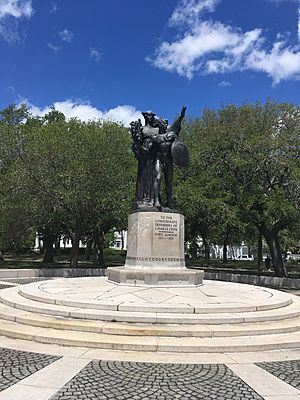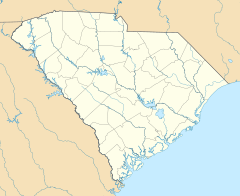Confederate Defenders of Charleston facts for kids

Confederate Defenders of Charleston (2018)
|
|
| Coordinates | 32°46.165′N 79°55.743′W / 32.769417°N 79.929050°W |
|---|---|
| Location | White Point Garden, Charleston, South Carolina |
| Designer | Hermon Atkins MacNeil |
| Fabricator | Delano & Aldrich Rudier Foundry |
| Material | Bronze Granite |
| Height | 17 feet (5.2 m) |
| Dedicated to | Confederate soldiers from Charleston |
The Confederate Defenders of Charleston is a monument located in Charleston, South Carolina, United States. This monument was built to honor Confederate soldiers from Charleston. It especially recognizes those who fought at Fort Sumter during the American Civil War.
A local person who gave a lot of money, Andrew Buist Murray, provided the funds for the monument. It was designed by Hermon Atkins MacNeil. The monument was officially opened in White Point Garden in 1932. It stands about 17 feet (5.2 m) tall. The monument features two bronze statues: a defender holding a sword and shield, standing in front of a symbol of the city of Charleston.
Contents
History of the Monument
How the Monument Came to Be
The American Civil War took place from 1861 to 1865. In April 1861, Confederate forces attacked Fort Sumter near Charleston. This fort was held by the Union Army. The Confederates took control of the fort and kept it until 1865.
After the war, people in Charleston wanted a monument to honor the Confederate soldiers. They especially wanted to remember those who fought at Fort Sumter. This idea became popular in the early 1900s.
In 1928, a kind person named Andrew Buist Murray passed away. He was a well-known philanthropist from Charleston. In his will, he left $100,000 to build this monument. The local group called the United Daughters of the Confederacy was in charge of making it happen.
Designing and Building the Monument
Hermon Atkins MacNeil was chosen to design the monument. The company Delano & Aldrich from New York City worked on the architecture. Some parts of the monument were made by the Rudier Foundry in Paris.
MacNeil wanted the monument to show the defenders of Charleston as "stalwart youth." He wanted them to look like strong young people protecting the fort and the city. He also wanted to show them defending their families. The total cost to build the monument was between $80,000 and $90,000.
The Dedication Ceremony
The monument was placed in Charleston's White Point Garden. Its dedication ceremony took place on October 20, 1932. Burnet R. Maybank, who was the Mayor of Charleston at the time, made that day a public holiday. This allowed city workers to attend the ceremony.
About 8,000 people came to the dedication. Several important people from the area led the event. Bishop Albert Sidney Thomas gave the opening prayer. Bishop Emmet M. Walsh gave the closing blessing.
The main speaker was Gerald W. Johnson, a writer for The Evening Sun newspaper. He spoke about the soldiers honored by the monument. Several Confederate veterans were also there. Four women, who were descendants of soldiers from Fort Sumter, officially unveiled the monument.
After the unveiling, a Confederate flag was placed at the monument's base. People said this flag was the last one to fly over Fort Sumter. Two wreaths made of white and red carnations were also placed there.
The Monument's Place in History
The monument was dedicated during a special time in Charleston. This period was called the Charleston Renaissance. During this time, the city grew in many ways. There was a boost in the arts and efforts to protect old buildings. This also helped tourism in Charleston.
People who promoted the city highlighted its history. They focused on its Southern culture. Many monuments honoring Charleston's history were built then. The Defenders monument was one of them. Historians note that the idea of the Lost Cause of the Confederacy was strong during this time. This idea was a way some people remembered the Civil War. It often focused on the bravery of the soldiers and the idea of states' rights.
Design of the Monument
The monument has a bronze statue on top of a granite base, called a pedestal. The main figure is a warrior. This warrior represents the Confederate soldiers from Charleston. He wears a fig leaf and sandals. He holds both a sword and a shield. The shield has the Seal of South Carolina on it.
Behind the warrior stands a female figure. She symbolizes the city of Charleston. She looks like an Amazon or an "Athena-like" figure. She holds a laurel wreath. This wreath is a reward for the warrior.
These statues are about 10 feet 6 inches (3.20 m) tall. They stand on an eight-sided pedestal that is about 6 feet 6 inches (1.98 m) tall. The monument is in the middle of a large circular area. This area is about 56.5 feet (17.2 m) wide.
The monument's pedestal has several important messages carved into it. On the front, it says:
TO THE
CONFEDERATE
DEFENDERS OF
CHARLESTON
FORT SUMTER
1861–1865
Below this, another message wraps around the pedestal:
COUNT THEM HAPPY WHO FOR THEIR FAITH AND THEIR COURAGE ENDURED A GREAT FIGHT.



